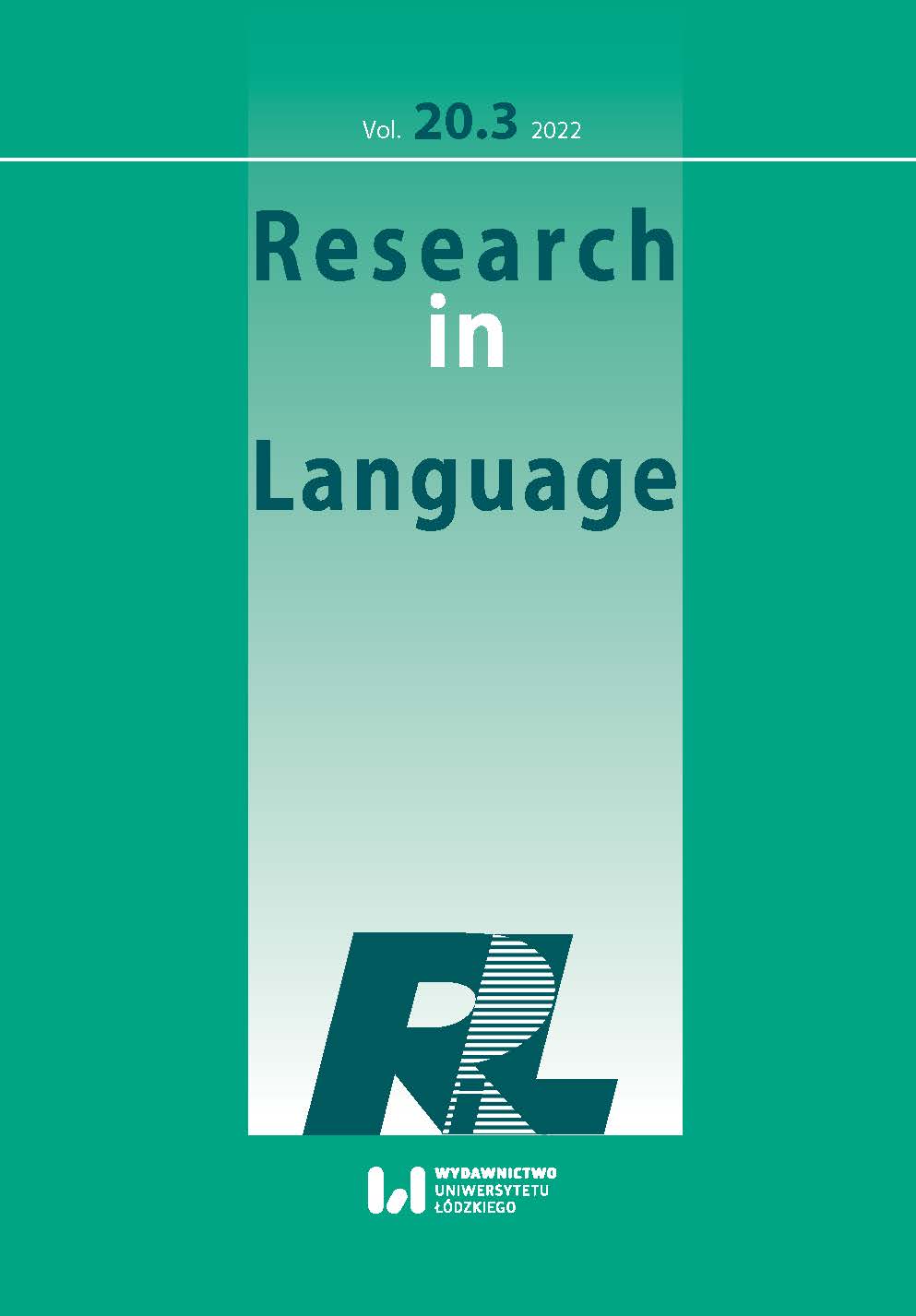What every EFL Instructor Needs to Know: Effective Implementation of Needs Analysis
DOI:
https://doi.org/10.18778/1731-7533.20.3.05Keywords:
needs analysis, needs assessment, learner needsAbstract
One of the first issues that any foreign language teacher needs to take into consideration prior to commencing on their language course is the implementation of a comprehensive learner needs analysis (NA) also referred to as needs assessment. Garnering information on, among others, students’ learning preferences, their previous learning experience or their goals is pivotal in order to design a course that would cater to students’ different needs and meet their expectations. A one-size-fits-all approach is not in line with the reality of language teaching in the 21st century, hence the need for the introduction of NA during language classes.
The aim of the following article is to explore the area of needs analysis – examine its beginnings and further development; define its basic components and also investigate the different data-collection instruments language teachers have at their disposal. The article will also present the results of a pilot study exploring Polish teachers’ perspectives on the introduction of needs analysis in the foreign language classroom.
References
Allwright, D. (1982). Perceiving and pursuing learners' needs. In M. Geddes and G. Sturtridge, (eds.), Individualisation, pp. 24-31. Oxford: Modern English Publications.
Google Scholar
Altschuld, J. W., & Witkin, B. R. (2000). From Needs Assessment to Action: Transforming Needs into Solution Strategies. New York: Sage.
Google Scholar
Brindley, G. (1984). Needs Analysis and Objective Setting in the Adult Migrant Education Program. Sydney: New South Wales Adult Migrant Education Service.
Google Scholar
Brown, J. D. (2016). Introducing Needs Analysis and English for Specific Purposes. Oxford: Routledge.
Google Scholar
DOI: https://doi.org/10.4324/9781315671390
Coffey, B. (1984). State of the art article: ESP – English for specific purposes. Language Teaching 17, 2–16.
Google Scholar
DOI: https://doi.org/10.1017/S0261444800010405
Cowling, D. (2007). Needs analysis: Planning a syllabus for a series of intensive workplace courses at a leading Japanese company. English for Specific Purposes, 26, 426–442.
Google Scholar
DOI: https://doi.org/10.1016/j.esp.2006.10.003
Davies, A. (1981). Review of Munby, Communicative Syllabus Design, 1978. English Language Teaching Journal, 35, 472–473.
Google Scholar
DOI: https://doi.org/10.1093/elt/XXXV.4.472
Dörnyei, Z. (2007). Research Methods in Applied Linguistics. Oxford: Oxford University Press.
Google Scholar
English, L. M. 2005. International Encyclopaedia of Adult Education. New York: Palgrave Macmillan.
Google Scholar
Graves, K. (2000). Designing Language Courses. Boston: Heinle & Heinle.
Google Scholar
Hoadley-Maidment, E. (1983). Methodology for the identification of language learning needs of immigrant learners of English through mother-tongue interviews. In R. Richterich, (ed.), Case Studies in Identifying Language Needs, 39–51. Oxford: Pergamon/Council of Europe.
Google Scholar
Holliday, A. (1994). The house of TESEP and the communicative approach: the special needs of state English language education. ELT Journal, 48, 3–11.
Google Scholar
DOI: https://doi.org/10.1093/elt/48.1.3
Holliday, A., & Cooke, T. (1982). An ecological approach to ESP. Lancaster Practical Papers in English Language Education, 5, 123–143.
Google Scholar
Howatt, A. (1984). A History of English Language Teaching. Oxford: Oxford University Press.
Google Scholar
Hutchinson, T., & Waters, A. (1987). English for Specific Purposes: A Learning Centred Approach. Cambridge: Cambridge University Press.
Google Scholar
DOI: https://doi.org/10.1017/CBO9780511733031
Jasso-Aguilar, R. (2005). Sources, methods and triangulation in needs analysis: A critical perspective in a case study of Waikiki Hotel Maids. In M. Long, (ed.), Second Language Needs Analysis, 127–158. Cambridge: Cambridge University Press.
Google Scholar
DOI: https://doi.org/10.1017/CBO9780511667299.005
Jones, C. (1991). An integrated model for ESP syllabus design. English for Specific Purposes, 10, 155–172.
Google Scholar
DOI: https://doi.org/10.1016/0889-4906(91)90022-O
Jordan, R.R., & Mackay, R. (1973). A survey of the spoken English problems of overseas postgraduate students at the universities of Manchester and Newcastle-upon-Tyne. Journal of the Institute of Education of the Universities of Newcastle-upon-Tyne and Durham, 125.
Google Scholar
Long, M. (2015). Second Language Acquisition and Task-based Language Teaching. New York: Wiley.
Google Scholar
Long, M. H. (2005). Second Language Needs Analysis. Cambridge: Cambridge University Press.
Google Scholar
DOI: https://doi.org/10.1017/CBO9780511667299
Mackay, R. 1978. Identifying the nature of learners' needs. In R. Mackay and A. Mountford, (eds.), English for Specific Purposes, 21-42. London: Longman.
Google Scholar
Munby, J. (1978). Communicative Syllabus Design. Cambridge: Cambridge University Press.
Google Scholar
Nelson, M. (1992). A model for course design in ESP for Business. Unpublished M.Ed. TESOL dissertation. University of Manchester.
Google Scholar
Pawlak, M. (2009). Metodologia badań nad strategiami uczenia się. In M. Pawlak (ed.) Metody Badań w Językoznawstwie Stosowanym. Neofilolog. Czasopismo Polskiego Towarzystwa Neofilologicznego, 32, 65–83.
Google Scholar
DOI: https://doi.org/10.14746/n.2009.32.6
Richterich, R. (1971). Analytical classification of the categories of adults needing to learn foreign languages. In J. Trim, J. Van Ek & D. Wilkins, (eds.), Systems Development in Adult Language Learning, 63–88. Strasbourg: Council of Europe/Oxford: Pergamon.
Google Scholar
Stuart, W. & Lee, E. (1972). The non-specialist use of Foreign Languages in Industry and Commerce. Sidcup: London Chamber of Commerce & Industry Examinations Board.
Google Scholar
Tarone, E., & Yule, G. (1989). Focus on the Language Learner. Oxford: Oxford University Press.
Google Scholar
Trendak-Suślik, O. (2015). Exploring the Role of Strategic Intervention in Form-focused Instruction. Heidelberg – New York: Springer.
Google Scholar
DOI: https://doi.org/10.1007/978-3-319-12433-9
West, M. (1926). Bilingualism (with special reference to Bengal). Calcutta: Bureau of Education, India.
Google Scholar
West, R. (1994). Needs analysis in language teaching. Language Teaching, 27, 15–49.
Google Scholar
DOI: https://doi.org/10.1017/S0261444800007527
White, C., Schramm, K., & Chamot, A. U. (2007). Research methods in strategy research: Reexamining the toolbox. In A. D. Cohen and E. Macaro, (eds.), Language Learner Strategies¸ 93-116. Oxford: OUP.
Google Scholar
Wilkins, D. (1976). Notional Syllabuses. Oxford: Oxford University Press.
Google Scholar
Woodraw, L. (2018). Introducing Course Design in English for Specific Purposes. London: Routledge.
Google Scholar
DOI: https://doi.org/10.4324/9781315143279
Downloads
Published
How to Cite
Issue
Section
License

This work is licensed under a Creative Commons Attribution-NonCommercial-NoDerivatives 4.0 International License.










